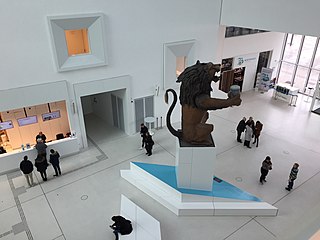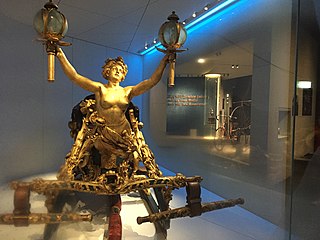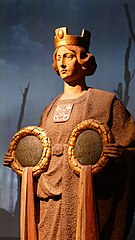House of Bavarian History: Museum
The House of Bavarian History , also: Museum of Bavarian History in the old town of Regensburg on the southern bank of the Danube is a museum about the new and latest Bavarian history . Richard Loibl is the founding director . The museum opened on June 5, 2019.
The museum's permanent exhibition covers an area of 2500 m² from the founding of the Kingdom of Bavaria in 1806 to the present day . The museum is the first site- specific institution of the House of Bavarian History , which organizes the Bavarian State Exhibitions , which take place every year in a different region of Bavaria on a specific topic of Bavarian history.
Advance developments and goals
The museum was originally supposed to open for the 100th anniversary of the Free State of Bavaria in 2018. Due to a fire in an outbuilding in July 2017, the opening was delayed by a year. The museum is located in the former so-called Danube Market on the Donaulände immediately south of the Iron Bridge over the Danube. The architecture of the new building takes into account the course of the former alleys on the site, but the design of the facade in particular is the subject of controversial discussion on site. Construction and furnishing of the museum cost around 95 million euros.
The then Bavarian Prime Minister Horst Seehofer announced in his government statement on December 10, 2008 that he wanted to establish a Bavarian State Museum of History. A competition was announced to find a location.
On May 17, 2011, the Bavarian State Minister for Science and Art, Wolfgang Heubisch , presented his cabinet colleagues with the catalog of criteria for a suitable museum location drawn up by the House of Bavarian History . An internal area of at least 11,000 m² was required for depots, exhibition rooms, restaurants and administration. Another prerequisite was that the place was “symbolic” for Bavarian history. The place should reflect the history of democracy and the structural change in the Free State of Bavaria.
On December 7th, 2011 it was announced that the project on the Danube market in Regensburg should be realized. Seehofer and the committee for the choice of location received criticism because the city of Regensburg was already presented as a favorite in the run-up to the official announcement. The opaque procedure was also criticized by the media and political parties.
Alternative applications from municipalities
Numerous cities applied, including Kulmbach in Upper Franconia, Nuremberg in Middle Franconia, Bad Kissingen and Würzburg in Lower Franconia , Sulzbach-Rosenberg in Upper Palatinate , Burghausen in Upper Bavaria , Freising , Ingolstadt , Marktl am Inn , Neuburg an der Donau and Scheyern , and Bogen in Lower Bavaria , Eggenfelden , Kelheim , Landshut and Passau as well as Straubing and Viechtach , in Swabia Kempten , Augsburg , Babenhausen , Bad Grönenbach , Buxheim and Höchstädt . Some of these cities made specific suggestions for locations. The city of Kempten wanted to house the history museum in the old mechanical cotton spinning and weaving mill . The shed roof hall made of brick , which was built in 1902 and is a listed building, has an internal usable area of 15,000 m² and is located directly on the river Iller . There are other free areas on the site. There are three historic bridges nearby, the Upper Illerbrücken . The building has been empty since 1993. Würzburg wanted to accommodate the museum on the site of the former Mozart School opposite the Würzburg Residence .
The museum building
The Danube market as a building site and its history
The museum building is located on the southern bank of the Danube on an elevated flood-proof area southeast of the Iron Bridge and east of St. Georgen-Platz and the Kolpingstrasse, which runs to the south . Including the outdoor facilities, the museum area has dimensions of 300 m in a west-east direction along the Danube. To the east, the area is bounded by the residential development that was newly built after 2010 and by the Austrian barn , which is to serve as a storage facility for the museum in the future. In a south-north direction, the museum area measures approx. 150 m from the Ostengasse to the south to the Uferstraße (Danube Lands), where there are berths for Danube ships. In the south towards the city, the area encompasses the former Hunnenplatz , the development of which, apart from a single house, had already been demolished after 1954 in order to enable the bypassing of the then newly built Kolping House. The last house on the original Hunnenplatz was demolished before the construction work began.
In the north, the museum area extends to the Danube area, which the residents of Regensburg have called the Danube Market since the end of the Second World War . The Danube market has a special meaning in the building history of Regensburg after the Second World War and for the very conflict-laden traffic planning in Regensburg that began after 1960. Only the decision to build the museum ended many disputes.
The development of the Danube market began when, towards the end of the war, the large urban grain warehouse built west of the Austrian Stadel in 1890 was hit by bombs and completely destroyed. The small-scale commercial and residential developments to the west of the destroyed warehouse to St. Georgen-Platz formed an inhabited port area and, with the port railway , whose tracks ran up to the Iron Bridge, even had a connection to the large port facilities east of the Nibelungen Bridge .
20 years after the end of the war, the previously undeveloped open-air area of the destroyed grain warehouse - the Danube market - was considerably enlarged when in 1964 the entire development of the associated harbor district, which remained largely undamaged, was demolished. The city council, led by Mayor Rudolf Schlichtinger , had decided to use the area created by the demolitions for a gigantic transport project. Two four-lane streets, an east-west and a south-north-city highway, should cross here. A suitably large and high Danube bridge - the so-called Bayerwaldbrücke - was to lead the south-north road northwards through the Salzstadel (Stadtamhof) and through the Stadtamhof district into the river valley of the rain and thus the city of Regensburg for the southern and northern communities open up. As a so-called Danube parallel, the inner-city east-west street was intended to connect the residential areas newly built in the west of the city after the war with the industrial areas in the east of the city. .
After fierce disputes, the road construction plans finally failed after the local elections in 1978. The entire Danube market area remained undeveloped and was still used as a car park and weekly market. Several times a planned development of the site with major projects (Convention Center) was by referendums rejected the city's population. It was not until the museum was built that the residents of Regensburg approved. Then in 2012 the archaeological investigations and the documentation of the still existing foundations of the former development of the Danube market began. The excavations covered around 15,000 m² and were a stroke of luck, because it was possible to dig in the middle of an existing city.
From the museum terrace, two wide flight of stairs lead down to the Uferstrasse, which has been known as the Danube Lands since 1903 and was part of the port of Regensburg until the end of the Second World War. Today the port only begins east of the Nibelungen Bridge and at the level of the former Royal Villa there are berths for cruise ships on the Danube .
Construction work
The architecture competition for the museum building was won in 2013 by the architects Wörner Traxler Richter from Frankfurt am Main, who also built the building. The Free State of Bavaria provided 63.9 million euros and the City of Regensburg 3.4 million euros for the financing. The costs for the new building increased by 21 million euros from the estimated 67.3 million euros to 88.3 million euros. The increase was due to the fire at the Bavariathek and the resulting dismantling measures.
The foundation stone was laid on May 22nd, 2015 by the Bavarian Prime Minister Seehofer .
Exhibition concept
The permanent exhibition "How Bavaria became a free state and what makes it so special" is arranged chronologically and is supplemented by 8 thematically structured so-called culture cabinets, for example on the Bavarian dialects or an overview of festivals and customs and deals with the period from 1800 to Present.
The main part is the permanent exhibition on the first floor with the themes
- Bavaria becomes a kingdom
- Will Bavaria become a nation?
- Royal drama Ludwig II.
- Bavaria becomes a myth
- World War and Free State
- Dictatorship - catastrophe - new beginning
- Reconstruction - economic miracle
- Turning point
- What determines the present and the future?
Around a third of the exhibits were provided privately. The 80 m² "cathedral window" facing the old town makes the Regensburg Cathedral with its two towers the "most important exhibit of the exhibition".
The Süddeutsche Zeitung describes the museum concept as anecdotal but clearly structured and considers the museum to be a “fully family-friendly world of experience”. The use of media in museums is perceived differently: the culture blog Schnabel ascribes little knowledge to “interactive digital buttons”. The Würzburger Katholische Sonntagsblatt, on the other hand, is enthusiastic about the “digital refinements” and “hands-on stations” that encourage “understanding Bavaria's history”. The museum responded to criticism of the lack of clarity with directional arrows and additional lighting. Clichés are questioned through more in-depth text material, yet the focus is on entertainment.
View of the permanent exhibition
There are also various portals on Bavarian history on the museum's website .
In the special exhibition area, the Bavarian State Exhibition 2019/2020 entitled 100 Treasures from 1000 Years , which is dedicated to the period up to 1800, was shown from September 27, 2019 to March 8, 2020 .
In front of the museum there has been an 8.60-long, gold-leaf sculpture representing a catfish since autumn 2019 . It comes from the Berlin artists Cisca Bogman and Oliver Störmer, who won first prize in the nationwide competition "Art on the Danube Market".
See also
Web links
- Homepage
- regensburg.de: Museum of Bavarian History
- Construction project: Museum of Bavarian History In: Web presence of the Regensburg State Building Authority
Remarks
- ↑ Kolpingstrasse takes its name from the monstrous new building of the Kolping House, which was built in 1954 and which, like a bolt, separates St. Georgen-Platz, the Danube bank with the Iron Bridge and, today, the museum building from the old town. In order to be able to bypass this frame structure on both sides, considerable interventions in the old building were necessary. In the years that followed, the houses on Hunnenplatz to the east and south of the Kolping House and the Kallmünzergasse that ran south from there were demolished. In the west of the Kolping House, an underpass of the Kolping House was created for the new Kolpingstrasse by demolition, which was then widened 10 years later in 1964 when plans existed to replace the Iron Bridge with a four-lane bridge (so-called Bayerwaldbrücke), which was part of a motorway-like north -South traffic axis should be.
- ↑ The planning of the inner-city south-north-Stadt-Autostraße was closely related to the planning of the south-north motorway A93 , the originally planned route of which would have cut through the old town of Regensburg exactly on this inner-city south-north route
- ↑ The planned routes of the two four-lane inner-city motorways can still be traced today (2019) on already completed sections in different parts of the city. 1. south of the Danube in Reinhausen: southern Bayerwaldstrasse 2. north of the Danube in the east of the city: Adolf Schmetzer-Strasse 3. north of the Danube in the west of the city: Clermont Ferrand-Allee
Individual evidence
- ^ Katja Auer, Hans Kratzer: Historicus Bavariae . In: sueddeutsche.de . June 3, 2019, ISSN 0174-4917 ( sueddeutsche.de [accessed June 13, 2019]).
- ^ Museum of Bavarian History. Retrieved April 8, 2019 .
- ^ Huge crowd in the Bayern Museum . In: sueddeutsche.de . June 11, 2019, ISSN 0174-4917 ( sueddeutsche.de [accessed June 13, 2019]).
- ↑ https://www.museum.bayern/ausstellungen/familieausstellung.html
- ^ Museum of Bavarian History. Retrieved June 13, 2019 .
- ↑ Regensburg wins the bid. In: Mittelbayerische.de. December 7, 2011, accessed December 24, 2017 .
- ^ Sebastian Grosser: Museum of Bavarian History: Façade separates spirits. (No longer available online.) In: BR.de. November 9, 2017, archived from the original on June 14, 2018 ; accessed on December 24, 2017 .
- ↑ Sebastian Beck, Andreas Glas: “A project like this is unique” . In: sueddeutsche.de . June 3, 2019, ISSN 0174-4917 ( sueddeutsche.de [accessed June 13, 2019]).
- ^ Gerhard Matzig: A good museum . In: sueddeutsche.de . June 5, 2019, ISSN 0174-4917 ( sueddeutsche.de [accessed June 13, 2019]).
- ^ Ute Wessels: The Museum of Bavarian History in Regensburg is opened . In: pz-news.de . May 31, 2019. Accessed June 13, 2019.
- ↑ art-magazin.de, Regensburg wants Bavarian State Museum: The city of Regensburg wants to secure the envisaged state-wide museum on Bavarian history ( Memento from July 14, 2014 in the Internet Archive )
- ↑ augsburger-allgemeine.de, Augsburg fights for a second state museum
- ↑ Free voters complain about the Museum for Regensburg! In: www.wochenblatt.de, November 24, 2011 (accessed December 4, 2011)
- ↑ 25 location applications for the new State Museum of Bavarian History ( Memento from August 1, 2012 in the Internet Archive )
- ↑ mainpost.de, Martin Seidel suggests camera for Bavarian State Museum
- ^ City of Ingolstadt, application for the Bavarian State Museum - OB video statement from August 8, 2011
- ↑ Lokalnews.de, Passau is applying for a piece of real Bavaria. Bavarian State Museum: A treat
- ↑ a b augsburger-allgemeine.de, State Museum in Kempten? Building a bridge between yesterday and today
- ↑ augsburger-allgemeine.de, State Museum for Höchstädt? Schloss should go into the race
- ↑ Andrea Kümpfbeck: 200 years full of ups and downs. In: Main-Post. Main-Post GmbH, June 3, 2019, accessed on November 30, 2019 .
- ^ Karl Bauer: Regensburg Art, Culture and Everyday History . 6th edition. MZ-Buchverlag in H. Gietl Verlag & Publication Service GmbH, Regenstauf 2014, ISBN 978-3-86646-300-4 , p. 404 .
- ↑ Susanne Wiedamann: The Danube Market revealed its secrets. The Mitelbayerische Zeitung, April 12, 2016, accessed on July 21, 2019 .
- ^ Museum of Bavarian History by Wörner Traxler Richter . In: architekturzeitung.com . May 20, 2019. Retrieved August 16, 2019.
- ^ Money from Munich in FAZ of August 9, 2014, page 13
- ↑ By Isolde Stöcker-Gietl November 24, 2017 3:02 p.m .: Fire in the museum remains unexplained. Retrieved September 19, 2019 .
- ↑ By Isolde Stöcker-Gietl December 7th, 2017 8:36 am: Cost explosion at Museum am Donaumarkt. Retrieved September 19, 2019 .
- ↑ Foundation stone laid for the Museum of Bavarian History . In: welt.de . May 22, 2015. Accessed May 22, 2015.
- ↑ The Museum of Bavarian History opens Bayerischer Rundfunk , June 4, 2019
- ^ Regensburg: The Museum for Bavaria is open! Website of the Bavarian State Ministry for Science and Art , as of June 6, 2019.
- ↑ House of Bavarian History: permanent exhibition. History white-blue - from 1800 to today. Retrieved May 3, 2020 .
- ^ Museum of Bavarian History in Regensburg: “The image of Bavaria includes the cliché” Richard Loibl in conversation with Anna Kohn. Deutschlandfunk , June 4, 2019
- ↑ The most beautiful exhibit - The House of Bavarian History offers an 80m² mirror for the Regensburg cathedral towers. Website of the Diocese of Regensburg , June 7, 2019.
- ↑ Sebastian Beck: House of Bavarian History: Bayerische Erlebniswelt Süddeutsche Zeitung , June 3, 2019
- ↑ Michaela Schabel: Regensburg - Exhibition "How Bavaria became a Free State and what makes it so special." In the new Museum of Bavarian History June 22, 2019
- ↑ Matthias Risser: Look into the memory of white-blue Würzburger Katholisches Sonntagsblatt, August 13, 2019
- ↑ From the monarchy to the CSU: Wolfram Kastner criticizes the Museum of Bavarian History Website of the Federation for Spiritual Freedom , last updated on June 27, 2019
- ↑ Sebastian Beck: House of Bavarian History: Bayerische Erlebniswelt Süddeutsche Zeitung , June 3, 2019
- ↑ Michaela Schabel: Regensburg - Exhibition "How Bavaria became a Free State and what makes it so special." In the new Museum of Bavarian History June 22, 2019
- ^ Bavaria website of the House of Bavarian History - Museum, accessed on September 12, 2019
- ↑ Bavarian State Exhibition “100 Treasures from 1000 Years” Website House of Bavarian History , as of September 12, 2019
- ↑ Anne-Lena Schug: Goldener 870 kilo catfish set up in Regensburg. In: Bayerischer Rundfunk. October 16, 2019, accessed November 24, 2019 .
Coordinates: 49 ° 1 ′ 11.6 ″ N , 12 ° 6 ′ 11.5 ″ E






















